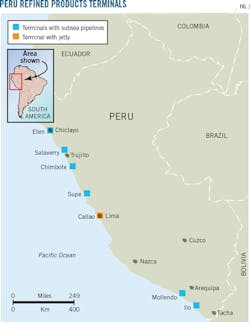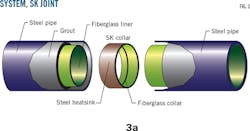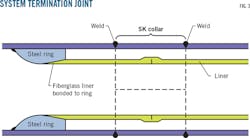Multiwall pipeline application improves product terminal operations
Kenneth Tierling
Unisert Multiwall Systems Inc.
Conroe, Tex.
Fernando Zevallos Esparza
PetroPeru
Lima
A multiwall pipeline application has improved both the integrity and efficiency of pipes used in Peru to transport refined products to shore.
Peru is a net importer of refined products. The vast majority (nearly 80,000 b/d) of its refined products imports came from the US in 2014, according to the US Energy Information Administration. This was triple the amount imported from the US in 2008.
Petroperu owns seven fuel storage terminals along Peru's coast (Fig. 1). Eten's capacity is 403,000 bbl, Salaverry's 291,000 bbl, Chimbote's 322,000 bbl, Supe's 207,000 bbl, Callao's 1-million bbl, Mollendo's 845,000 bbl, and Ilo's 210,000 bbl. Peru's Grana y Montero Petrolera and Oiltanking GMBH operate the Eten, Salaverry, Chimbote, Supe, and Callao terminals. Mollendo and Ilo supply 500-Mw powerplants.
Subsea pipelines carry product arriving on tankers to all of these terminals except Callao, which uses a jetty. On completion of product discharge the pipes are flushed with sea water, reducing the risk of a possible refined products spill due to hose failure.
Residual ballast water, however, is common when emptying a tanker compartment. Adding hose flush water to the ballast water creates an electrolyte that allows galvanic and sulfate reducing bacterial corrosion. Resulting corrosion rates have been very aggressive, resulting in a 4-year life expectancy for the subsea pipelines.
Petroperu monitors pipeline integrity via annual pressure tests but has examined other options, including intelligent pigging, internal coatings, and internal liners. The pipelines' short 1-4 km length and the ability to put pig traps only on the shore end limits pigging's viability. Pigs would either need to be reversed out of the line or retrieved by wire line. Either procedure presents risks at the subsea end as the lines would need to be altered to accommodate subsea pig capture and retrieval.
The pipes' 4-year mean life expectancy would require annual pig runs to obtain sufficient data to project a replacement date within the useful pipeline life and eliminate risk of a spill event. But projecting life expectancy in environments with trace amounts of sea water and sulfate reducing bacterial pitting corrosion is tenuous at best. Variations in bacterial colony development cause corrosion rates to vary dramatically, increasing the risk-to-cost ratio of smart pigging as a possible solution.
Pipeline weld areas are of concern in any aggressive corrosive environment given the difficulties they pose in performing in situ cleaning effectively enough to yield holiday-free internal coating. Disbonding can create bubbles in the coating and coating failure even in areas away from the welds, accelerating pitting corrosion. The high pitting tendency of these ship-to-shore pipelines and resultant likely acceleration of pitting corrosion made internal coating a poor integrity management option.
Internal-liner material, meanwhile, must be compatible with the refined products transported through the system. A fiber-reinforced plastic (FRP) liner using an amine-cured epoxy is often used in similar applications. The delta of the permeation rates between the steel and the FRP do not allow pressure to build in the annular space, eliminating concerns about liner collapse.
PetroPeru chose the multiwall IT3 system (Fig. 2) to rehabilitate its old pipelines and use in construction of any new lines. The three-layered system has a minimum 50-year life expectancy.
The system creates a multiwall pipe consisting of a plastic liner installed inside the steel pipe and a cement-based grout squeezed between the two layers. The plastic can be fiberglass, polyethylene, polyvinyl chloride, or any number of other plastics, including specialty high-temperature or acid-handling materials.
Separating the plastic carrier pipe from the steel containment pipe allows installation without flanges and limits liner stress to within the elastic deformation range. An amine-cured epoxy acts as a long-pass insulator, preventing fluid from contacting the steel pipe's inner wall.
Filling the annular space with grout transmits hoop strain to the steel and locks the liner in place. The grout's pH passivates the steel. Filling the annulus with a solid material also forms a single cathodic protection (CP) environment, with both the interior and exterior of the line protected by one program.
Using helium to create a small annular pressure and monitoring this for changes allows detection of damage to either the internal or external piping. Periodic inspection of the CP rectifier's current requirements will also indicate any possible coating problems. If any defects exist these can be found subsea and repaired. The ability to constantly monitor the double-wall system in these two ways makes it a better option for integrity management than intelligent pigging.
In addition to rehabilitating existing lines, the multiwall pipe can be manufactured for greenfield installation. Newbuild pipelines feature a coupling device called the SK collar (Fig. 2) which simultaneously joins the steel and fiberglass layers.
Fig. 3 shows how a newly lined segment can be connecting to an existing unlined pipe. The final segment of lined pipeline features an internal steel ring which acts as both an anchor for the liner and a dam for the grout annulus filling.
Operational experience
Each PetroPeru products terminal consists of a minimum of two ship-to-shore pipelines: one for clean products (gasoline, JP-5 jet fuel, No. 2 diesel, etc.) and the other for fuel oils (No. 4, 6, and Bunker C).
The clean product lines were primarily 12-in. OD steel and had 10-in. liner installed. The resulting high C factor (smoothness) allayed concerns that the reduced diameter would require additional offloading time. No change in offloading time was noted.
The fuel oil lines were predicted to require 30% additional offloading time but use of the liner reduced the required time by 30% instead. Calculations before the work did not account for the 50-55° F. water's cooling effect and resultant jelling of the heavy oil. The liner and grout helped reduce heat loss, allowing the product to arrive onshore warmer and with lower viscosity.
The lines first installed in Peru are approaching 10 years of service without corrosion failure. They have also demonstrated impact resistance.
A Navy vessel set adrift by a storm sank and came to rest on top of one of the pipelines, paralleling the coast. Wave action moved the vessel along the pipe into shallower waters towards the beach and eventually compromised its steel outer case. The line was pressure tested, found intact, and remained in service with constant annular monitoring.
The inner liner remained uncompromised and the pipeline was eventually taken out of service without a spill and replaced by a new IT3 system, the surf zone being too hazardous for the diving operations required to either repair or relocate the old one.
The authors
Kenneth Tierling ([email protected]) is founder and president of Unisert. Tierling has worked in the pipeline installation and services industry since 1960 and developed the IT3 multiwall piping system. He formed Unisert in the mid-1970s in Edmonton, Alta., and eventually relocated to Texas. In 2009 Ken Tierling founded Unisert Peru SRL, servicing Latin America.
Fernando Zevallos Esparza is head of PetroPeru's operating agreements unit, having started with the company as a project engineer in 1983. He earned a BS (1982) in civil engineering from Pontificia Universidad Catolica del Peru, Lima and a second bachelors (1985) in systems analysis from the same school. He holds a graduate degree (2006) in project management from Universidad Peruana de Ciencias Aplicadas, Lima, and earned his masters (2016) in strategic business management from Centrum Catolica, Lima.



